Classification of Snow Cover Persistence across China
Abstract
:1. Introduction
2. Data and Methodology
2.1. Data Sources
2.2. Definitions and Methods
- (1)
- SCD: snow cover day, any day with snow cover in each pixel for each snow year;
- (2)
- SSL: snow season length, the number of days from the first to the last snow cover day in each snow year;
- (3)
- ASCD: the accumulated snow cover days in each snow year;
- (4)
- CSCD: the continuous snow cover days in each snow year;
- (5)
- RAL: the ratio of ASCD to SSL, reflecting the variability of snow cover; and
- (6)
- Long-term mean annual ASCD, CSCD, and RAL: averaged annual values in the snow years for 1981–2019.
3. Results and Discussion
3.1. Climatology of Snow Cover Classification
3.2. Interdecadal Variations in Snow Cover Classification
3.3. Snow Cover Distribution in Sub-Regions for Snow Cover Classification
4. Conclusions
Author Contributions
Funding
Institutional Review Board Statement
Informed Consent Statement
Data Availability Statement
Acknowledgments
Conflicts of Interest
References
- Flanner, M.G.; Shell, K.M.; Barlage, M.; Perovich, D.K.; Tschudi, M.A. Radiative forcing and albedo feedback from the Northern Hemisphere cryosphere between 1979 and 2008. Nat. Geosci. 2011, 4, 151–155. [Google Scholar] [CrossRef]
- You, Q.; Wu, T.; Shen, L.; Pepin, N.; Zhang, L.; Jiang, Z.; Wu, Z.; Kang, S.; AghaKouchak, A. Review of snow cover variation over the Tibetan Plateau and its influence on the broad climate system. Earth Sci. Rev. 2020, 201, 103043. [Google Scholar] [CrossRef]
- Beniston, M.; Farinotti, D.; Stoffel, M.; Andreassen, L.M.; Coppola, E.; Eckert, N.; Fantini, A.; Giacona, F.; Hauck, C.; Huss, M.; et al. The European mountain cryosphere: A review of its current state, trends, and future challenges. Cryosphere 2018, 12, 759–794. [Google Scholar] [CrossRef] [Green Version]
- Zhong, X.; Zhang, T.; Kang, S.; Wang, K.; Zheng, L.; Hu, Y.; Wang, H. Spatiotemporal variability of snow depth across the Eurasian continent from 1966 to 2012. Cryosphere 2018, 12, 227–245. [Google Scholar] [CrossRef] [Green Version]
- Zhong, X.; Zhang, T.; Kang, S.; Wang, J. Spatiotemporal variability of snow cover timing and duration over the Eurasian continent during 1966–2021. Sci. Total Environ. 2021, 750, 141670. [Google Scholar] [CrossRef]
- Zhong, X.; Zhang, T.; Su, H.; Xiao, X.; Wang, S.; Hu, Y.; Wang, H.; Zheng, L.; Zhang, W.; Xu, M.; et al. Impacts of landscape and climatic factors on snow cover in the Altai Mountains, China. Adv. Clim. Chang. Res. 2021, 12, 95–107. [Google Scholar] [CrossRef]
- Formozov, A.N. Snow cover as an integral factor of the environment and its importance in the ecology of mammal and birds. Mater. Fauna Flora USSR 1946, 5, 1–152. [Google Scholar]
- Rikhter, G.D. Snow Cover, Its Formation and Properties; U.S. Army Cold Regions Research and Engineering Laboratory: Hanover, NH, USA, 1954; p. 66. [Google Scholar]
- Gold, L.W.; Williams, G.P. Some Results of the Snow Survey of Canada; National Research Council of Canada-Division of Building Research: Ottawa, ON, Canada, 1957; p. 8. [Google Scholar]
- Benson, C.S. Stratigraphic Studies in the Snow and Firm of the Greenland Ice Sheet; RR 70, NTIS AD 288219; U.S. Army Cold Regions Research and Engineering Laboratory: Hanover, NH, USA, 1962; p. 93. [Google Scholar]
- Irwin, G.J. Snow Classification in Support of Off-Road Vehicle Technology; Report 801; Defense Research Establishment of Canada: Ottawa, ON, Canada, 1979; p. 22. [Google Scholar]
- Roch, A. Report on Snow and Avalanches Conditions in the USA. Western Ski Resorts from 1 January to 24 April 1949; Federal Institute for Research on Snow and Avalanches-Weissfluhjoch-Davos of Switzerland: Davos, Switzerland, 1949; p. 39. [Google Scholar]
- Benson, C.S. Reassessment of Winter Precipitation on Alaska’s Arctic Slope and Measurements on the Flux of Wind Blown Snow; UAG R-288; Geophysical Institute, University of Alaska: Fairbanks, AK, USA, 1982; p. 26. [Google Scholar]
- Potter, J.G. Snow Cover; Technical Report No. 3; Department of Transport-Meteorological Branch of Canada: Toronto, ON, Canada, 1965; p. 69.
- McKay, G.A.; Findlay, B. Variations of snow resources with climate and vegetation in Canada. In Proceedings of the 39th Annual Meeting Western Snow Conference, Billings, MT, USA, 20–22 April 1971; pp. 17–26. [Google Scholar]
- McKay, G.A.; Gray, D.M. The distribution of snowcover. In Handbook of Snow; Gray, D.M., Male, D.H., Eds.; Pergamon Press: Oxford, UK, 1981; pp. 153–190. [Google Scholar]
- Sturm, M.S.; Holmgren, J.; Liston, G.E. A seasonal snow cover classification system for local to global applications. J. Clim. 1995, 8, 1261–1283. [Google Scholar] [CrossRef] [Green Version]
- Sturm, M.S.; Liston, G.E. Revisiting the global seasonal snow classification: An updated dataset for earth system applications. J. Hydrometeor. 2021, 22, 2917–2938. [Google Scholar] [CrossRef]
- Royer, A.; Domine, F.; Roy, A.; Langlois, A.; Marchand, N.; Davesne, G. New northern snowpack classification linked to vegetation cover on a latitudinal mega-transect across northeastern Canada. Écoscience 2021, 28, 225–242. [Google Scholar] [CrossRef]
- The Great Soviet Encyclopedia; Macmillan Publishers: New York, NY, USA, 1979.
- Lehning, M.; Grünewald, T.; Schirmer, M. Mountain snow distribution governed by an altitudinal gradient and terrain roughness. Geophys. Res. Lett. 2011, 38, L19504. [Google Scholar] [CrossRef] [Green Version]
- Grünewald, T.; Bühler, Y.; Lehning, M. Elevation dependency of mountain snow depth. Cryosphere 2014, 8, 2381–2394. [Google Scholar] [CrossRef] [Green Version]
- Zhang, T. Influence of the seasonal snow cover on the ground thermal regime: An overview. Rev. Geophys. 2005, 43, RG4002. [Google Scholar] [CrossRef]
- Wang, S.; Zhou, L.; Wei, Y. Integrated risk assessment of snow disaster over the Qinghai-Tibet Plateau. Geomat. Nat. Haz. Risk 2019, 10, 740–757. [Google Scholar]
- Rößler, S.; Witt, M.S.; Ikonen, J.; Brown, I.A.; Dietz, A.J. Remote sensing of snow cover variability and its influence on the runoff of Sápmi’s Rivers. Geosciences 2021, 11, 130. [Google Scholar] [CrossRef]
- Kim, J.; Kim, Y.; Zone, D.; Oechel, W.; Park, S.; Lee, B.; Yi, Y.; Erb, A.; Schaaf, C.L. Carbon response of tundra ecosystems to advancing greenup and snowmelt in Alaska. Nat. Commun. 2021, 12, 6879. [Google Scholar] [CrossRef]
- Li, P.; Mi, D. Distribution of snow cover in China. J. Glaciol. Geocryol. 1983, 5, 9–18, (In Chinese with English Abstract). [Google Scholar]
- He, L.; Li, D. Classification of snow cover days and comparing with satellite remote sensing data in West China. J. Glaciol. Geocryol. 2011, 33, 237–245, (In Chinese with English Abstract). [Google Scholar]
- Zhang, T.; Zhong, X. Classification and regionalization of seasonal snow cover across the Eurasian Continent. J. Glaciol. Geocryol. 2014, 36, 481–490, (In Chinese with English Abstract). [Google Scholar]
- Chen, S.; Wang, X.; Guo, H.; Xie, P.; Wang, J.; Hao, X. A Conditional Probability Interpolation Method Based on a Space-Time Cube for MODIS Snow Cover Products Gap Filling. Remote Sens. 2020, 12, 3577. [Google Scholar] [CrossRef]
- Hao, X.; Huang, G.; Che, T.; Ji, W.; Sun, X.; Zhao, Q.; Zhao, H.; Wang, J.; Li, H.; Yang, Q. The NIEER AVHRR snow cover extent product over China—A long-term daily snow record for regional climate research. Earth Syst. Sci. Data 2021, 13, 4711–4726. [Google Scholar] [CrossRef]
- Brown, R.D. Northern Hemisphere snow cover variability and change, 1915–1997. J. Clim. 2000, 13, 2339–2355. [Google Scholar] [CrossRef]
- IPCC. Climate change 2013: The physical science basis. In Contribution of Working Group I to the Fifth Assessment Report of the Intergovernmental Panel on Climate Change; Stocker, T.F., Ed.; Cambridge University Press: Cambridge, UK; New York, NY, USA, 2013; p. 1535. [Google Scholar]
- Zhang, Y.; Kang, S.; Sprenger, M.; Cong, Z.; Gao, T.; Li, C.; Tao, S.; Li, X.; Zhong, X.; Xu, M.; et al. Black carbon and mineral dust in snow cover on the Tibetan Plateau. Cryosphere 2018, 12, 413–431. [Google Scholar] [CrossRef] [Green Version]
- Zhong, X.; Kang, S.; Zhang, W.; Yang, J.; Li, X.; Zhang, Y.; Liu, Y.; Chen, P. Light absorbing impurities in snow cover across Northern Xinjiang, China. J. Glaciol. 2019, 65, 940–956. [Google Scholar] [CrossRef] [Green Version]
- Huang, X.; Deng, J.; Ma, X.; Wang, Y.; Feng, Q.; Hao, X.; Liang, T. Spatiotemporal dynamics of snow cover based on multi-source remote sensing data in China. Cryosphere 2016, 10, 2453–2463. [Google Scholar] [CrossRef] [Green Version]
- Che, T.; Hao, X.; Dai, L.; Li, H.; Huang, X.; Xiao, L. Snow cover variation and its impacts over the Qinghai-Tibet Plateau. Bull. Chin. Acad. Sci. 2019, 34, 1247–1253. [Google Scholar]
- Hu, R.; Ma, W.; Liu, J. Snow disasters in China. In Snow and Its Disaster Control in China; Hu, R., Ed.; China Environmental Science Press: Beijing, China, 2013; Volume 10, pp. 183–201. ISBN 978-7-5111-1429-7. [Google Scholar]
- Notarnicola, C. Hotspots of snow cover changes in global mountain regions over 2000–2018. Remote Sens. Environ. 2020, 243, 111781. [Google Scholar] [CrossRef]
- Bulygina, O.N.; Razuvaev, V.N.; Korshunova, N.N. Changes in snow cover over Northern Eurasia in the last few decades. Environ. Res. Lett. 2009, 4, 45026. [Google Scholar] [CrossRef]
- Niittynen, P.; Heikkinen, R.K.; Luoto, M. Snow cover is a neglected driver of Arctic biodiversity loss. Nat. Clim. Chang. 2018, 8, 997–1001. [Google Scholar] [CrossRef]

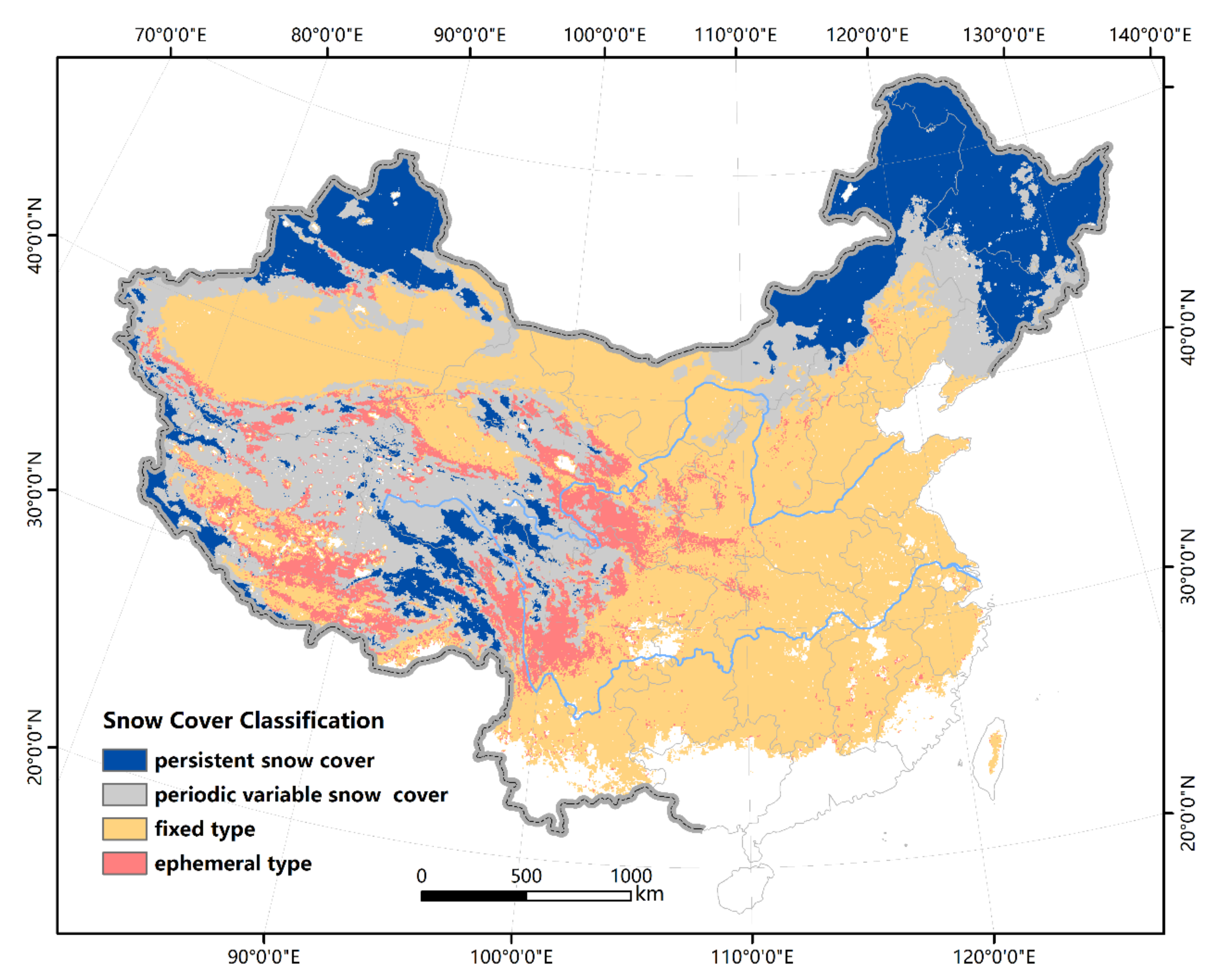
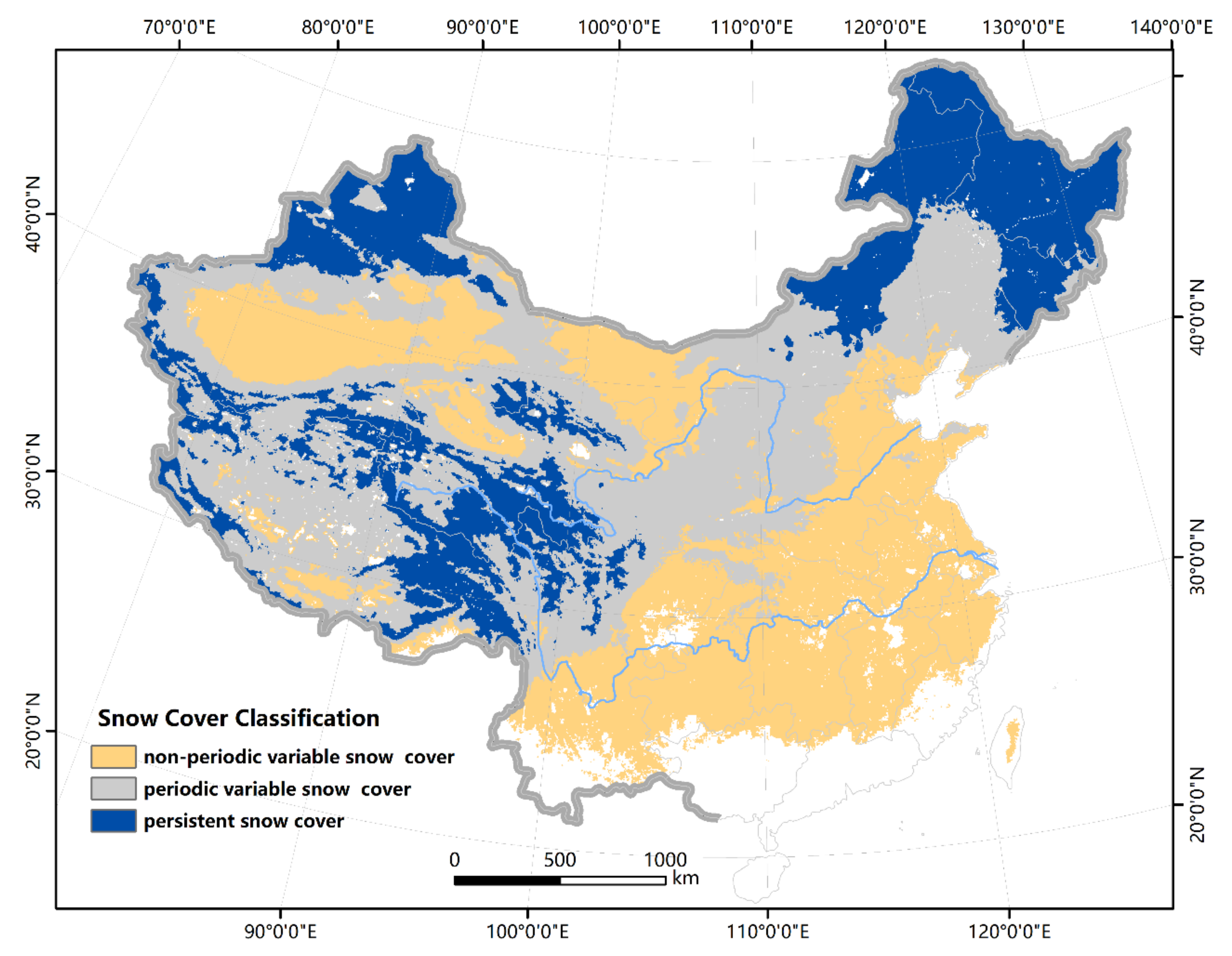
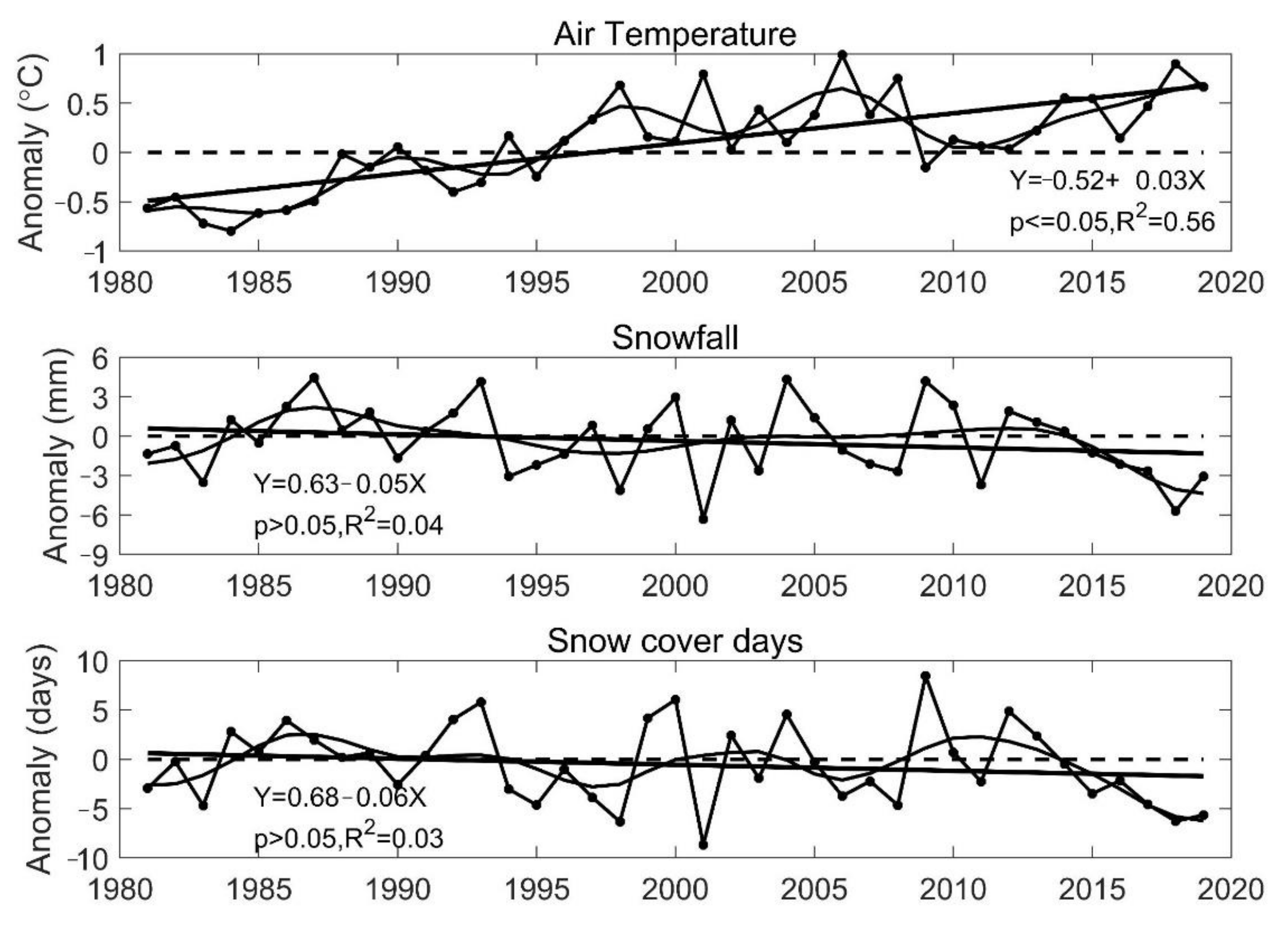
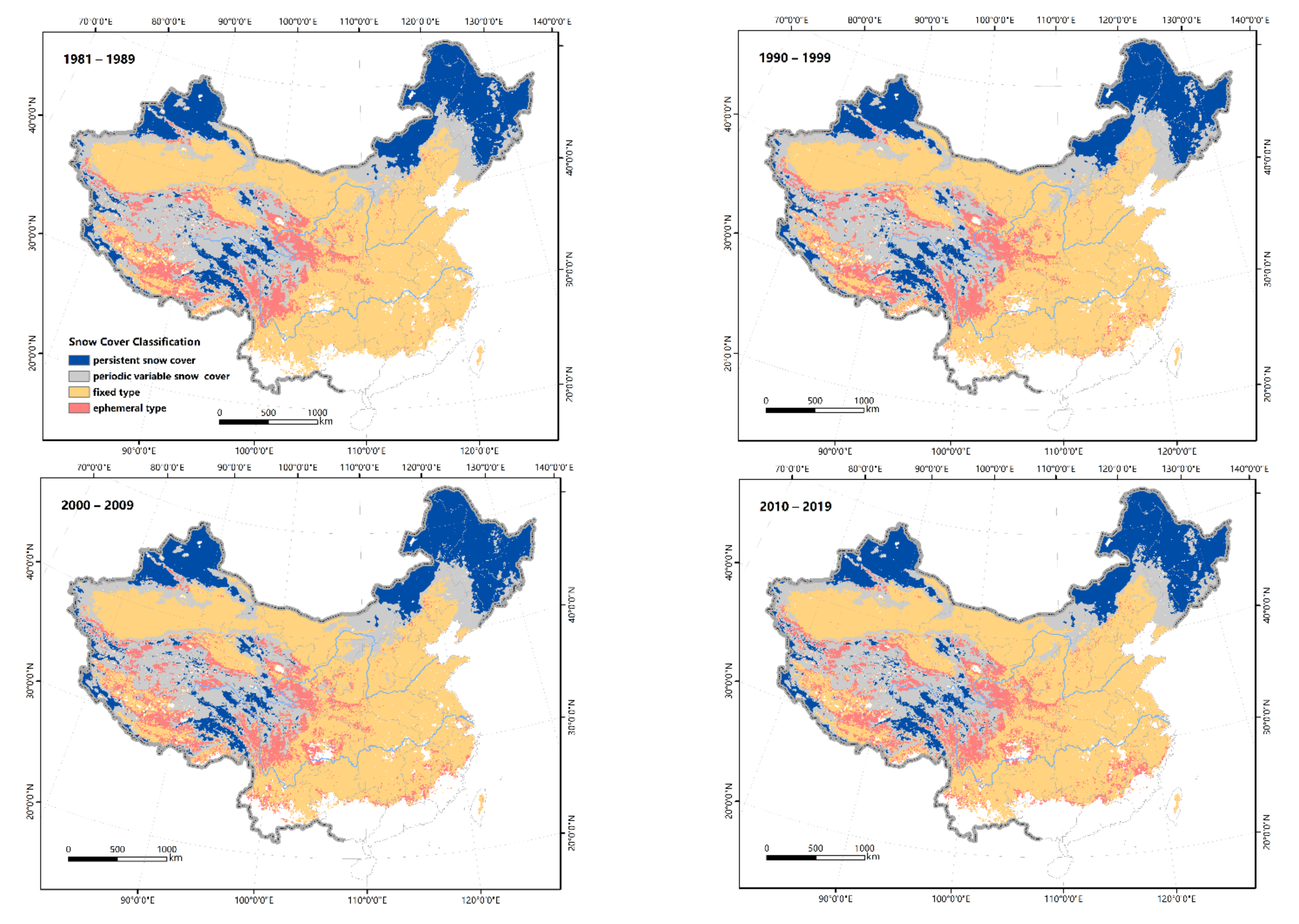
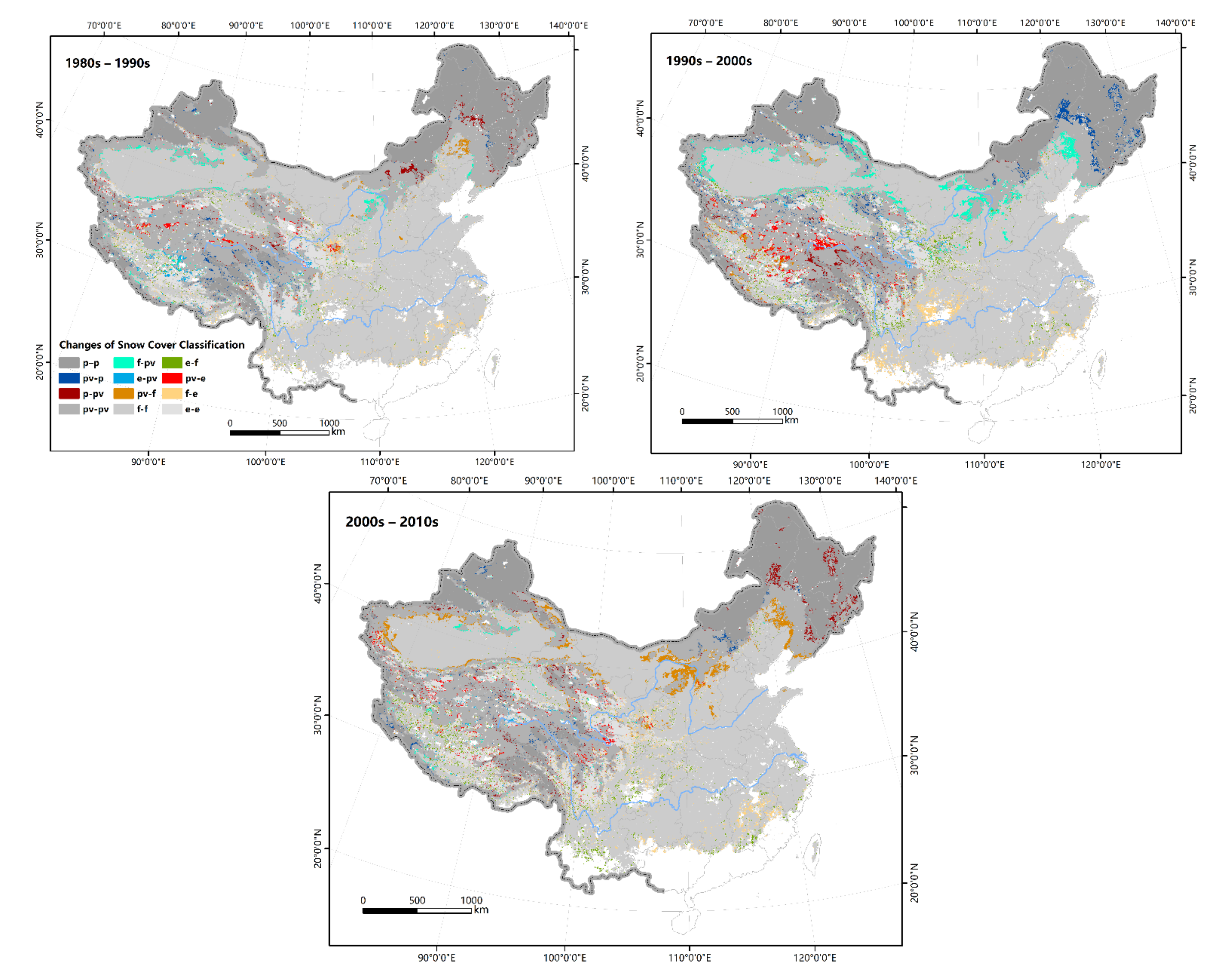
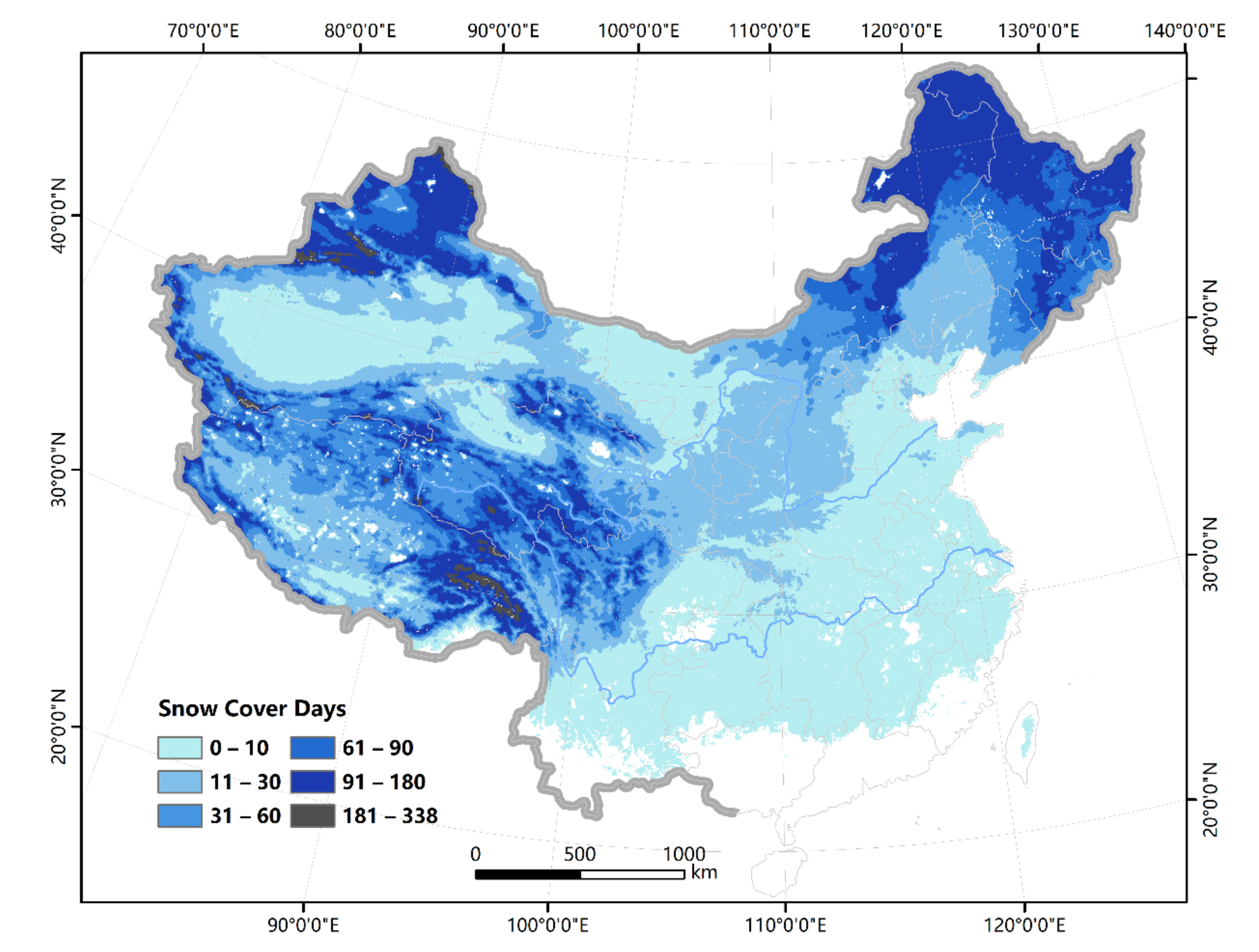
| Snow Classification | Snow Cover Extent (×104 km2) | Rate of Change in Extent (%) | ||||||
|---|---|---|---|---|---|---|---|---|
| 1981–2019 | 1980s | 1990s | 2000s | 2010s | 1990s | 2000s | 2010s | |
| Persistent snow cover | 190.12 | 190.32 | 187.93 | 197.64 | 190.91 | −1.26 | 5.17 | −3.41 |
| Periodic variable snow cover | 206.48 | 205.19 | 209.97 | 210.74 | 195.97 | 2.33 | 0.37 | −7.01 |
| Fixed-type | 419.71 | 420.34 | 414.5 | 397.35 | 413.67 | −1.39 | −4.14 | 4.11 |
| Ephemeral-type | 69.92 | 70.38 | 73.82 | 80.5 | 85.67 | 4.89 | 9.05 | 6.42 |
Publisher’s Note: MDPI stays neutral with regard to jurisdictional claims in published maps and institutional affiliations. |
© 2022 by the authors. Licensee MDPI, Basel, Switzerland. This article is an open access article distributed under the terms and conditions of the Creative Commons Attribution (CC BY) license (https://creativecommons.org/licenses/by/4.0/).
Share and Cite
Li, H.; Zhong, X.; Zheng, L.; Hao, X.; Wang, J.; Zhang, J. Classification of Snow Cover Persistence across China. Water 2022, 14, 933. https://doi.org/10.3390/w14060933
Li H, Zhong X, Zheng L, Hao X, Wang J, Zhang J. Classification of Snow Cover Persistence across China. Water. 2022; 14(6):933. https://doi.org/10.3390/w14060933
Chicago/Turabian StyleLi, Hongxing, Xinyue Zhong, Lei Zheng, Xiaohua Hao, Jian Wang, and Juan Zhang. 2022. "Classification of Snow Cover Persistence across China" Water 14, no. 6: 933. https://doi.org/10.3390/w14060933
APA StyleLi, H., Zhong, X., Zheng, L., Hao, X., Wang, J., & Zhang, J. (2022). Classification of Snow Cover Persistence across China. Water, 14(6), 933. https://doi.org/10.3390/w14060933







